Posted on 6th Oct 2023

Electric motors are used in multiple applications of our everyday lives but require the right amount of electrical energy to provide optimal torque and speed. According to CM Industry Supply Automation, to control these motors, Lenze Drive, are used to convert AC current into DC current from the power supply. In this article we will look at how these devices work, and how they are important
In 1887, Nikola Tesla obtained a patent for the first three-phase AC motor, which outperformed Thomas Edison's DC motor in terms of durability and efficiency. However, it was challenging to regulate the speed of AC motors, which led to the dependability of DC motors. Small parts that gave rise to then-current VFDs weren't designed until many years later. Initially utilized in heavy industry, VFDs later found more widespread application as technology advanced. The development of microprocessors and control circuitry have given VFDs a great deal of versatility while reducing the strain on the motor.
Converter, DC link, Inverter, Control Logic, and User interface are the five basic parts of a VFD.
The rectifier or converter aids in converting the AC voltage to a DC voltage. The converter consists of a number of parallel-connected diodes that only permit current to flow in one direction. The converter cycles through the electricity that is currently being used until a rough DC voltage is created.
Filter inductors and capacitors make up the filtering component of DC Link. The rippling DC voltage that was received from the rectifier circuit in the preceding step is smoothed using DC Link. The inverter's input is then fed with the filtered output.
The inverter's job is to change the filtered DC voltage that comes out of the DC link's output back into AC. The variable voltage, variable frequency output to the motor is managed by the inverter. IGBT switches are used in the inverter, which are coupled in pairs to regulate the flow of electricity. This is typically attached to a logic controller that enables a user to interact with it and modify the motor's voltage. From a DC source, AC voltage can be generated by pulse-width modulating the direction of electrical flow.
The configuration of the Keb Drive requires a user interface in order to achieve optimal power utilization or conserve energy. A control panel that is connected to a VFD and allows for manual user input is called a user interface. These can be a touch screen LCD or a keypad. Bluetooth wireless control panels are available with newer systems.
The Control logic then interprets the user-defined setting. It is the software required for the user interface and feedback device on the motor to communicate with the VFD. The program is typically based on a state diagram, which executes a series of steps before finishing an activity from beginning to end. This enables complete automation of the VFD.
According to CM Industry Supply Automation - Servo Drive and Servo Motor Expert, VFDs such as Siemens Drive, Darwin Motion Drive, Lenze Drive, Keb Drive etc. are a refinery that converts erratic AC voltage into a more reliable current. It can be improved even more by changing it to DC before being sent back out as an AC. It is possible to export current gradually because the voltage that is sent out has a square shape rather than the conventional sinusoidal one. Other advantages of VFDs include: